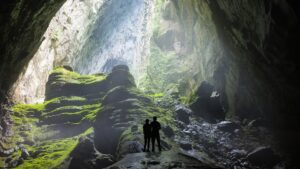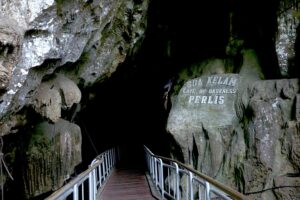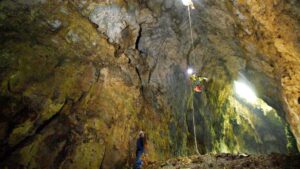Exploring the Wonders of Gua Jomblang Cave in Indonesia

Gua Jomblang, often referred to as the "Heavenly Light" cave, is a stunning natural wonder nestled within Indonesia’s rich volcanic landscape. Known for its dramatic vertical drop and unique light phenomena, this underground cave attracts adventure seekers, nature enthusiasts, and photographers from around the world. Its mysterious depths and breathtaking features make Gua Jomblang a must-visit site for those interested in exploring Indonesia’s diverse geological and ecological treasures. This article provides an in-depth look at Gua Jomblang, from its geological origins to visitor guidelines, offering a comprehensive understanding of this extraordinary subterranean environment.
Location and Geographical Features of Gua Jomblang Cave
Gua Jomblang is located in the Gunung Kidul region of Yogyakarta, Indonesia, a province renowned for its karst landscape and limestone formations. The cave is part of a larger complex of caves and underground rivers that have shaped the region’s rugged terrain. Situated approximately 50 kilometers south of the city of Yogyakarta, Gua Jomblang is accessible via well-maintained roads that wind through lush forests and agricultural fields. The entrance to the cave is a vertical shaft that drops sharply into the earth, revealing a mysterious dark opening amid dense greenery.
The surrounding landscape is characterized by rugged limestone hills and narrow valleys, typical of karst topography. The area experiences a tropical climate with distinct wet and dry seasons, which influence the cave’s internal environment and surface features. The terrain is dotted with other caves and sinkholes, making the region a hotspot for spelunkers and adventure tourists. The geological setting provides a dramatic natural backdrop that underscores the cave’s significance as a geological and ecological site.
Gua Jomblang’s entrance is a vertical cylindrical hole, approximately 60 meters deep, leading to a vast underground chamber. The cave’s walls are steep, with some sections featuring stalactites and stalagmites that have formed over thousands of years. The vertical nature of the cave makes it a striking feature in the landscape, standing out as a natural sentinel amid the lush greenery. Its location within the karst landscape also means that the cave is interconnected with an underground river system, contributing to its unique ecosystem.
The geographical features of Gua Jomblang make it a prime example of karst topography, which is formed through the dissolution of soluble rocks like limestone. Over millions of years, water erosion has carved out this underground marvel, creating a complex network of tunnels, chambers, and vertical shafts. The surface features, including the surrounding hills and sinkholes, are direct results of this erosional process, making the area a fascinating destination for geological study and exploration.
In addition to its natural beauty, the location of Gua Jomblang offers picturesque views of the surrounding landscape. Visitors often enjoy panoramic vistas of the dense tropical forest and the distant mountains, providing a scenic context for their underground adventure. The accessibility from Yogyakarta also enhances its appeal, making it a convenient yet extraordinary destination for both casual tourists and serious explorers.
Geological Formation and Natural History of Gua Jomblang
Gua Jomblang’s formation dates back to the geological processes that shaped the region over millions of years. The cave is primarily a vertical sinkhole, created through the dissolution of limestone by acidic rainwater and groundwater over extensive periods. This process, known as karstification, gradually eroded the soluble rock, forming large underground chambers and vertical shafts that characterize the cave today. The cave’s formation is a testament to the dynamic natural forces that have sculpted the landscape of southeastern Java.
The natural history of Gua Jomblang is intertwined with the volcanic activity that has shaped much of Indonesia’s terrain. The region’s volcanic past contributed to the deposition of thick limestone layers, which later became susceptible to erosion and dissolution. Over time, the persistent action of water carved out the vertical shaft, exposing the underground chamber known as the “cave of death” because of its deep, dark entrance. The cave’s formation is a result of both tectonic movements and surface weathering processes, which continue to influence its structure.
Within the cave, geological features such as stalactites, stalagmites, and flowstones have developed over thousands of years. These formations are created by mineral-laden water dripping and depositing calcite, gradually building intricate structures that adorn the interior. The presence of these features provides insights into the cave’s climatic history and water chemistry over millennia. The layered deposits also serve as natural records of environmental changes, making Gua Jomblang a valuable site for scientific study.
The cave’s natural history extends to its role as an ecosystem habitat. Its underground environment supports specialized flora and fauna adapted to low-light conditions. The constant temperature and humidity levels within the cave help preserve delicate formations and biological communities. Additionally, the underground river system connected to Gua Jomblang has contributed to the development of unique subterranean aquatic ecosystems, which are still being studied by researchers.
Ongoing geological processes continue to shape Gua Jomblang, with minor collapses and sediment deposits influencing its structure over time. These natural changes are part of the cave’s dynamic history, illustrating the continual evolution of karst landscapes. Understanding its formation and natural history not only enhances appreciation for this underground marvel but also underscores the importance of preserving such geological sites for future generations.
Unique Vertical Drop and Vertical Cave Exploration Experience
One of the most striking features of Gua Jomblang is its dramatic vertical drop, which measures approximately 60 meters from the surface entrance to the bottom of the main chamber. This vertical shaft offers a challenging and exhilarating experience for adventure enthusiasts, as it requires specialized equipment and skills to navigate safely. The descent is often facilitated by rappelling or caving techniques, making it a popular activity for experienced spelunkers and thrill-seekers.
Exploring Gua Jomblang involves a combination of caving, rappelling, and sometimes even zip-lining, depending on the tour package. Visitors are usually guided by trained professionals who ensure safety while allowing participants to enjoy the adrenaline rush of descending into the underground abyss. The vertical nature of the cave demands careful planning and proper gear, including harnesses, helmets, and ropes, to prevent accidents and ensure a smooth exploration experience.
The interior of Gua Jomblang reveals a vast, open chamber at the bottom of the shaft, with impressive stalactites and stalagmites that have formed over thousands of years. The exploration journey provides a unique perspective on the geological processes that shaped the cave, offering both physical challenge and educational value. Many explorers describe the experience as awe-inspiring, with the sense of entering a hidden world beneath the surface.
The adventure doesn’t end at the descent; explorers can venture further into the cave’s interconnected passages, discovering underground streams, pools, and smaller chambers. Some tours include a swim in the underground river or a walk through narrow tunnels, enhancing the sense of discovery. The vertical drop is often considered the highlight of the expedition, combining physical effort with the thrill of exploring one of Indonesia’s most iconic vertical caves.
Safety is paramount during exploration, and the experience is typically limited to those with caving or climbing experience. Proper preparation, physical fitness, and adherence to guide instructions are essential for a safe and enjoyable adventure. The vertical exploration of Gua Jomblang offers an unforgettable experience that combines natural beauty, adrenaline, and a sense of achievement for those willing to take on its challenge.
The Luminous "Heavenly Light" Phenomenon at Gua Jomblang
One of Gua Jomblang’s most famous and captivating features is the natural light phenomenon known as the "Heavenly Light" or "Cahaya Surga." This optical spectacle occurs when sunlight penetrates through a vertical shaft or opening at the top of the cave, illuminating the dark chamber with a radiant, almost divine glow. The phenomenon is most visible during the dry season, typically from May to September, when the sunlight is unobstructed by rain or clouds.
This luminous effect creates an ethereal atmosphere within the cave, with the light illuminating the mist, stalactites, and stalagmites in a surreal display. Photographers and visitors often describe the experience as otherworldly, capturing images of the glowing light streaming into the darkness. The interplay of natural light and the cave’s geological features produces a spectacle that has earned Gua Jomblang international fame among nature photographers and adventure travelers alike.
The formation of this phenomenon is due to the precise alignment of the vertical shaft and the position of the sun. When sunlight enters the opening at just the right angle, it creates a beam of light that appears to descend from the surface, giving the impression of a celestial or heavenly presence. The effect is intensified by the humidity and dust particles suspended in the air, which scatter the light and enhance its brightness and visibility.
This natural light display has cultural and spiritual significance for local communities, who sometimes interpret it as a divine sign or blessing. It also serves as a major attraction for tourists, drawing visitors who wish to witness the awe-inspiring spectacle firsthand. The best time to experience the "Heavenly Light" is usually early morning or late afternoon, when the sun’s position optimizes the light’s entry into the cave.
Visitors are encouraged to plan their trip around these optimal lighting conditions to fully appreciate the phenomenon. Photography enthusiasts often bring tripods and wide-angle lenses to capture the perfect shot. The "Heavenly Light" at Gua Jomblang remains a testament to the natural wonder and poetic beauty of Indonesia’s underground landscapes, inspiring awe and reverence among those fortunate enough to witness it.
Flora and Fauna Found Within Gua Jomblang Cave Ecosystem
Despite its dark and seemingly inhospitable environment, Gua Jomblang hosts a surprisingly diverse array of flora and fauna adapted to subterranean life. The cave’s ecosystem is characterized by specialized species that thrive in low-light conditions, often forming symbiotic relationships with the mineral-rich environment. These



